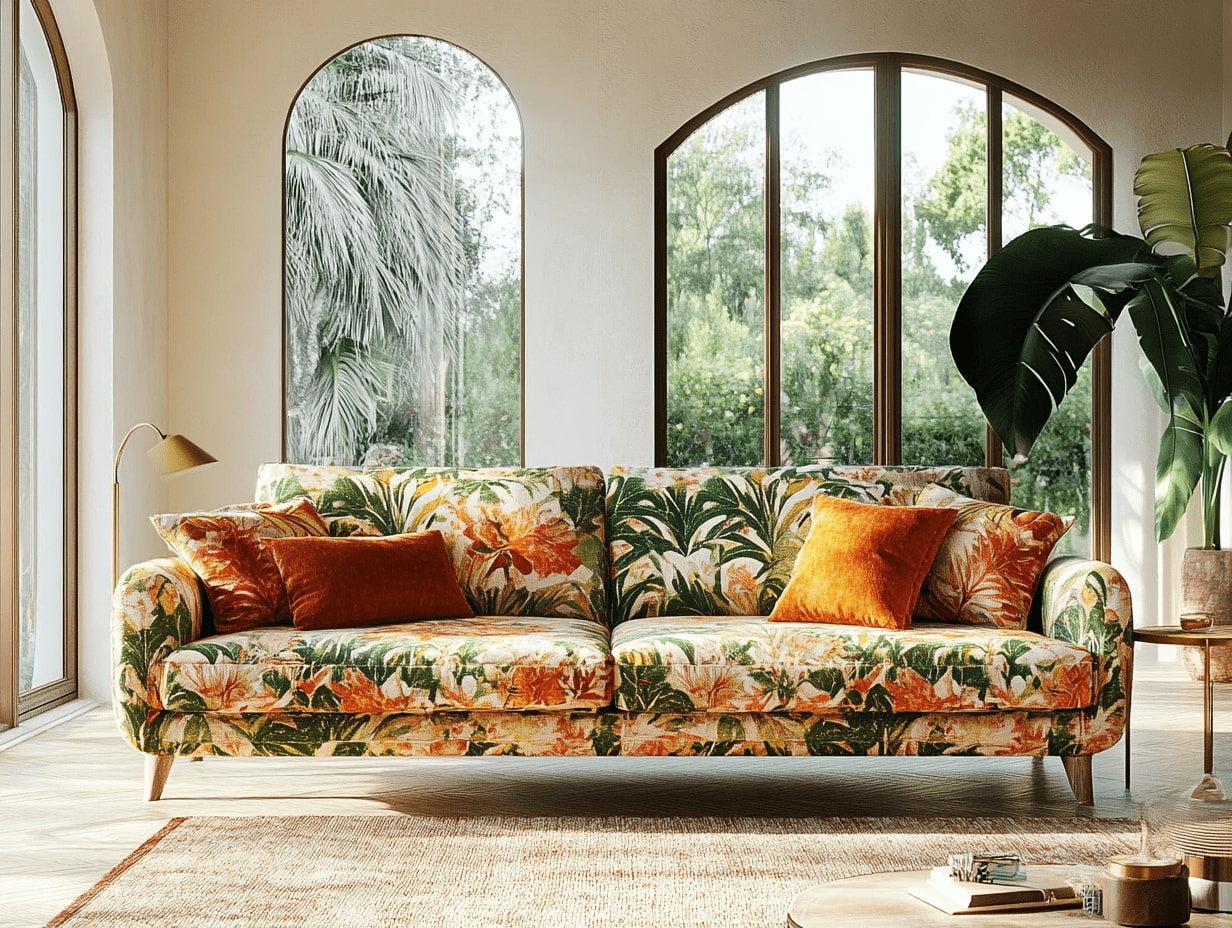When it comes to transforming a space, fabrics and textiles play a crucial role in setting the tone and enhancing the overall aesthetic. From luxurious silks to cozy wools, the right materials can elevate our interiors and furniture, bringing both comfort and style to our homes. With countless options available, choosing the perfect fabric can feel overwhelming, but understanding the basics helps us make informed decisions.
Textiles not only add color and texture but also influence the functionality of our spaces. Whether we’re looking for durability in a family room or elegance in a formal living area, selecting the appropriate fabric is key. As we explore the world of interior fabrics, we discover how they impact everything from mood to maintenance, guiding us in creating spaces that reflect our personal style and meet our practical needs. Let’s dive into the fascinating realm of textiles and uncover how they can transform our living environments.

Overview of Fabrics and Textiles
Fabrics play an integral role in interior design. From plush velvet to resilient cotton, materials define space aesthetics and functionality. Textiles impact the mood and usability of living environments. We must consider various factors such as durability, texture, and color when selecting materials to complement specific rooms.
Types of Materials
- Natural Fibers: Cotton, wool, and silk offer breathability and comfort. Wool is excellent for warmth and texture in rugs or blankets. Silk elevates the aesthetic of formal spaces with its sheen and softness.
- Synthetic Fibers: Polyester, nylon, and acrylic provide durability and ease of maintenance. Polyester is favored for stain resistance and longevity in high-traffic areas like family rooms. Nylon serves well in upholstery due to its strength.
- Upholstery: Choosing the right upholstery fabric balances style and practicality. Leather provides a classic and durable option for frequently used furniture. Linen is suitable for casual, elegant settings due to its breathable texture.
- Drapery and Curtains: Materials like velvet and silk contribute luxury and depth to windows. For lighter, airy aesthetics, cotton or linen allows natural light to infuse rooms while maintaining privacy.
Understanding the characteristics of various fabrics ensures informed decisions when designing interiors. This knowledge helps us create harmonious spaces tailored to personal tastes and needs.

Types of Fabrics for Interiors
Understanding the variety of fabrics available for interiors helps us make design choices that align with aesthetic and functional goals. We explore both natural and synthetic options to provide clarity in selection.
Natural Fabrics
Natural fabrics, such as cotton and wool, offer breathability and comfort. Cotton, a versatile material, adapts well to different styles, providing a soft, approachable feel in spaces. Wool adds warmth and texture, making it ideal for cozy interiors, particularly in colder climates. Silk, another popular choice, exudes luxury and elegance and works well in formal settings, enhancing visual appeal with its natural sheen. Linen gives a relaxed sophistication to rooms, known for its durability and earthy appearance.
Synthetic Fabrics
Synthetic fabrics include polyester and nylon, known for their durability and low maintenance. Polyester holds its shape well, resisting wrinkles and fading, making it perfect for high-use furniture pieces. Nylon offers significant strength and elasticity, suitable for areas needing abrasion resistance, like busy family rooms. Acrylic mimics wool’s softness yet provides better stain resistance, ideal for those seeking warmth without high maintenance. These materials, collectively, offer practical solutions without compromising style.
Textiles for Furniture
Textiles for furniture play a crucial role to define the aesthetic interior spaces. Selecting the right fabric can elevate the look and endurance of your furniture.
Upholstery Fabrics
Upholstery fabrics determine the longevity and comfort of furniture. Our choices often include:
- Leather: Known for its durability and timeless appeal, leather ages well and adds sophistication. It’s easy to clean and suitable for high-traffic areas, making it a top choice for family rooms.
- Linen: Offers a breathable, natural texture, providing a casual yet elegant feel. Though it wrinkles easily, it’s ideal for relaxed settings and offers a cooling effect.
- Velvet: Luxurious and soft, velvet adds a rich texture to furniture. Best used in low-traffic spaces, it brings opulence and depth to formal living rooms.
- Microfiber: Known for its stain resistance and softness, microfiber suits busy households due to its easy maintenance and durability.
Decorative Textiles
Decorative textiles enhance furniture with color and pattern. Our selections often feature:
- Pillows: Adding layers and comfort, throw pillows introduce patterns and textures. Opt for combinations in contrasting colors to create visual interest.
- Throws: Functional and stylish, throws provide warmth and can be draped over sofas or chairs. Wool and cashmere options offer luxurious warmth.
- Slipcovers: Protect furniture and easily update styles with slipcovers. Choosing a washable fabric facilitates maintenance while allowing seasonal changes.
- Tapestries: Used as wall hangings or spreads, tapestries bring artistic flair. They can be bold or subtle, adding personal expression to the space.
By understanding upholstery and decorative textile options, we can craft interiors that reflect our personal style and cater to our practical needs.

Factors to Consider When Choosing Fabrics
When selecting fabrics for interiors and furniture, several critical factors impact both aesthetics and functionality. These considerations ensure the textiles not only look good but also serve their intended purpose effectively.
Durability
Durability determines how well a fabric withstands wear and tear over time. For frequently used items like sofas or dining chairs, materials such as leather and microfiber offer superior resilience. For less-trafficked areas, options like velvet provide durability with a touch of luxury. It’s crucial to match the fabric’s strength to the item’s usage intensity.
Color and Pattern
Color and pattern play significant roles in setting the room’s tone and style. Lighter fabrics brighten spaces but show stains easily, while darker hues hide dirt but can darken rooms. Patterns add visual interest: bold designs make statements, whereas subtle prints blend in seamlessly. Consider the overall theme and desired atmosphere when choosing these elements.
Maintenance
Maintenance requirements affect the practicality of fabrics in everyday life. Low-maintenance fabrics like polyester and microfiber resist stains and require minimal upkeep, ideal for busy households. High-maintenance materials, such as silk, demand regular care and may not suit high-traffic areas. Understanding maintenance needs helps balance aesthetic appeal with cleaning convenience.

Trends in Interior Fabrics and Textiles
Sustainability has become a dominant trend in interior fabrics. Many designers now prioritize eco-friendly options, incorporating recycled materials and organic textiles into their collections. We see a rise in the use of fabrics like organic cotton, bamboo, and hemp, which offer sustainability without compromising on style.
Bold patterns and vibrant colors have gained popularity in recent years. These fabrics allow homeowners to make a statement, adding personality to their spaces. Geometric designs, botanical prints, and abstract patterns are particularly favored for their ability to enhance modern and eclectic interiors.
Performance fabrics are making waves due to their durability and functionality. These materials resist stains, fading, and wear while maintaining a stylish appearance, making them ideal for high-traffic areas and homes with children or pets. We find that microfiber, solution-dyed acrylics, and specially treated polyesters are the frontrunners in this category.
Textures are crucial in current textile trends. Combining various textures in a single space creates depth and visual interest. Textured weaves, bouclé, and plush velvets are often used to achieve this effect, providing contrast and softness to interior design.
Metallics and sheen have taken center stage as designers experiment with luxurious finishes. Metallic threads and iridescent fabrics add a touch of glamour and sophistication, perfect for those who wish to imbue their interiors with a bit of extravagance. These materials are often paired with muted colors to maintain a balanced and elegant look.
Neutral tones remain a staple in interior fabrics. While vibrant colors are gaining traction, neutral palettes offer versatility and timelessness. They serve as a backdrop, allowing other design elements to shine and creating a calm, cohesive environment.
By keeping abreast of these trends, we can curate interiors that reflect the latest in fabric innovation while ensuring comfort and style.
Sustainable and Eco-friendly Options
Sustainability in interior design isn’t just a trend, it’s an enduring commitment. We find that eco-friendly fabrics, such as organic cotton, recycled polyester, and linen, offer compelling advantages for both aesthetics and environmental impact. Organic cotton, grown without pesticides, provides a soft and durable option for upholstery and drapery. Recycled polyester repurposes existing materials, reducing waste while maintaining durability and easy maintenance. Linen, made from flax, is biodegradable and adds a timeless elegance to interiors with its natural texture.
Bamboo and hemp are other sustainable choices that bring unique qualities. Bamboo fabric, known for its strength and softness, is highly renewable and grows quickly without the need for fertilizers. Hemp, praised for its durability and mold resistance, uses less water compared to traditional crops and offers a rustic appeal perfect for casual and stylish settings.
Incorporating sustainable textiles ensures our interior spaces not only reflect personal taste but also contribute positively to the environment. Eco-friendly options not only deliver on style but also align with the principles of responsible sourcing and production. By selecting these materials, we support a healthier planet and promote sustainable practices across the textile industry.

Top Brands and Manufacturers
Leading fabric and textile brands set the benchmark for quality and innovation in interior design. These companies provide a vast range of options, catering to various styles and preferences. Here’s a closer look at some prominent names in the industry:
- Kravet Inc.: This family-owned business has been a staple for luxury textiles since 1918, offering an expansive collection from silk to cotton blends. Their focus on high-end aesthetics and designer collaborations makes them a favorite among interior designers.
- Sunbrella: Known for durability and resistance to fading, Sunbrella’s fabrics are ideal for both indoor and outdoor use. Their commitment to sustainability is evident through eco-friendly production processes and recycled materials.
- Schumacher: Established in 1889, Schumacher excels in creating iconic patterns and rich textures. Their offerings range from classic to contemporary styles, often featuring bold colors and intricate designs.
- Maharam: With a reputation for innovative textile designs, Maharam specializes in contemporary fabrics that emphasize aesthetics and functionality. The brand frequently collaborates with artists and designers to create unique collections.
- Ralph Lauren Home: Reflecting timeless elegance, Ralph Lauren Home fabrics combine classic styles with modern sensibilities. Their collection includes luxurious materials such as velvet and linen, perfect for sophisticated interiors.
By opting for reputable brands, we gain access to not only superior craftsmanship but also the assurance of quality and style in our fabric choices for interiors and furniture.
Conclusion
Fabrics and textiles play a pivotal role in enhancing interior spaces, marrying style with function. We’ve explored various materials, from luxurious silks to durable microfibers, and how their unique characteristics impact comfort and maintenance. Our discussion underscored the importance of selecting the right fabric to match both practical and aesthetic needs in our homes. By understanding the distinct properties of natural and synthetic fibers, we can make informed decisions that suit our personal style and lifestyle demands.








